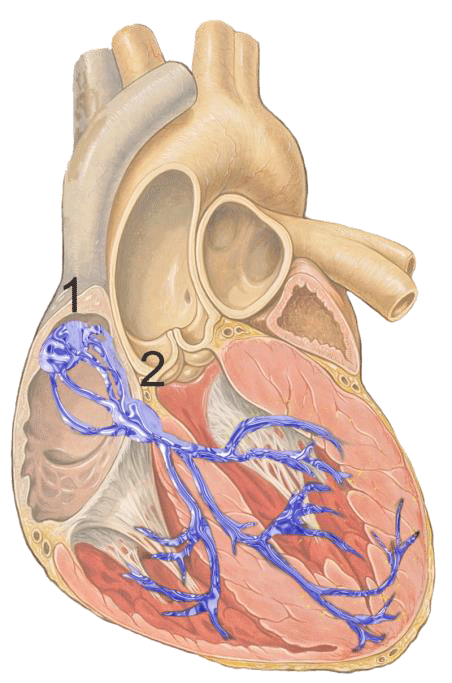Joseph R. Anticaglia MD
Medical Advisory Board
John is a 67 year old retired postal worker. He complained of being tired, lightheaded, having palpitations and being short of breath, the latter, especially after walking two or three blocks. A thorough cardiac evaluation pinpointed the problem. Calcium deposits formed on the heart’s aortic valve causing a narrowing of its opening and thereby reducing the flow of blood from the heart to his brain and the rest of the body.
He was advised to have aortic valve replacement surgery to relieve his symptoms and repair the aortic valve stenosis (narrowing) and thereby restore normal blood flow. His surgery was successful except that postoperatively he experienced an irregular heart rhythm, atrial fibrillation, that didn’t respond to medications. He thereafter underwent — electrical cardioversion — which successfully restored a normal heart rhythm.
Physiology Snapshot

The sinoatrial node is a special group of nerve cells (1) that act as the pacemaker of the heart; it starts the heartbeat. Ordinarily, the SA generates electrical nerve impulses from the upper, right atrial chamber of the heart that passes via the AV node (2) to the lower, ventricular chambers of the heart. When the heart is functioning normally, the nerve impulses signal the heart’s muscle to contract in a coordinated fashion.
Any malfunction in the conduction of electrical impulses to the cardiac muscle can result in abnormal heart beats that may be too fast (tachycardia) or not in rhythm (e. g. atrial fibrillation — AFib) causing patients’ symptoms. To put it another way, if the heart beats in an uncoordinated fashion, the heart muscle doesn’t fill up with enough blood nor is it capable of pumping enough blood throughout the body. This gives rise to patients’ complaints. Also, dangerous blood clots can form within the heart and break loose.
Electrical cardioversion is a procedure that converts an abnormal heart rhythm (which may be too fast or irregular) to a normal rhythm. During the procedure, low energy electricity is used to shock and restore the heart into a normal rhythm.

Soft pads with electrodes are commonly place on the skin of the chest which are connected to the cardioversion machine. Next, medication is given to make you fall asleep. Following this, one or more electrical shocks are delivered to the patient that travels through the electrodes to the heart to convert it into a normal sinus rhythm. The procedure usually takes a few minutes and the patient ordinarily goes home the same day.
Before Cardioversion, your doctor may order a transesophageal echocardiogram. She wants to know, for instance, if there are blood clots in your heart. Cardioversion can cause blood clots to break loose causing deadly complications such as strokes or pulmonary embolism. If cardiac clots are identified, the procedure is postponed for several weeks and you’re prescribed blood-thinning medication to minimize the risk of complications.
Complications of cardioversion are uncommon, but may include worsening of the arrhythmia, blood clots as noted above and discomfort where the electrodes were placed. For most people, the procedure is quick, safe and works to restore normal sinus rhythm. Discuss with your doctor the risks and benefits of the procedure and what precautions and medications you might take before and after cardioversion.
References
- Anthony H. Kashou et al; Physiology, Sinoatrial Node (SA Node); June 23, 2019
- NIH; Cardioversion
- Joseph R. Anticaglia, MD How Does the Healthy Heart Work? Doctor’s Column, 2019
This article is intended solely as a learning experience. Please consult your physician for diagnostic and treatment options.

